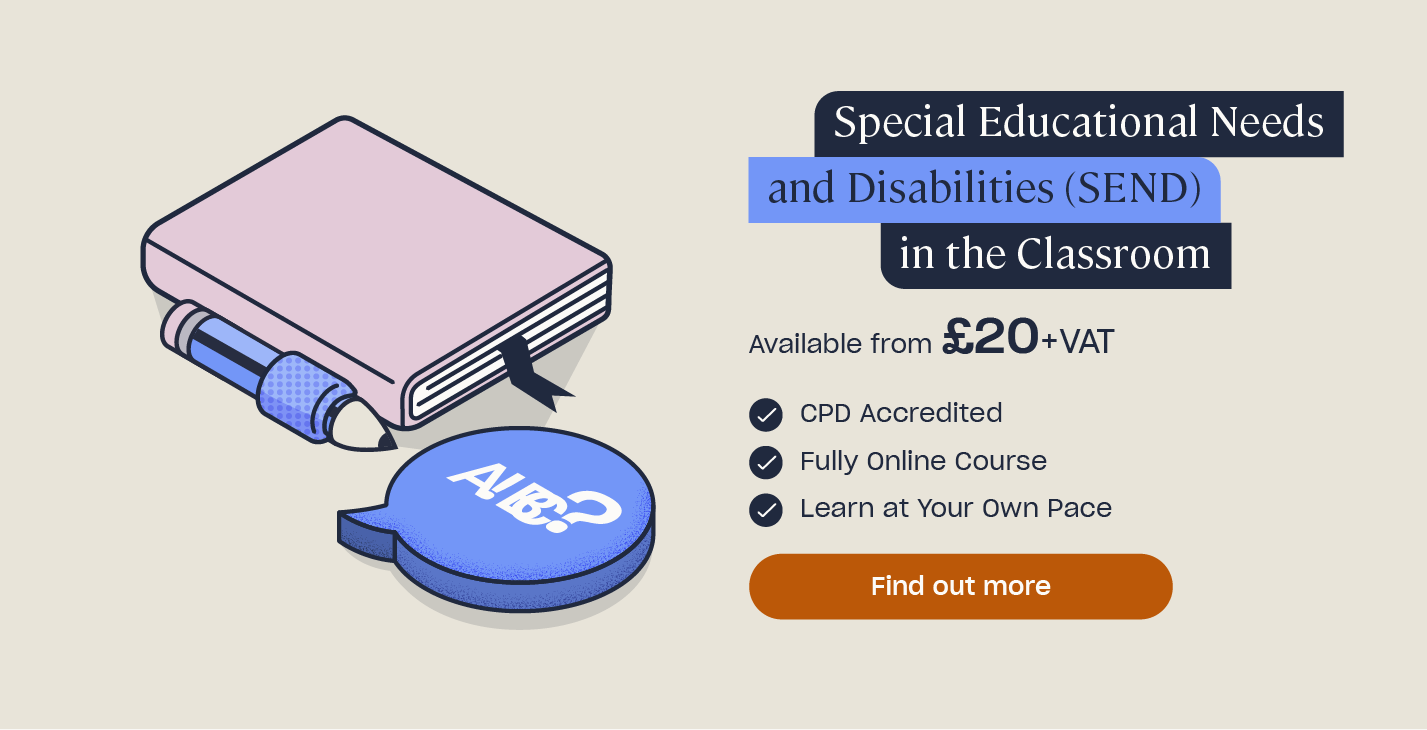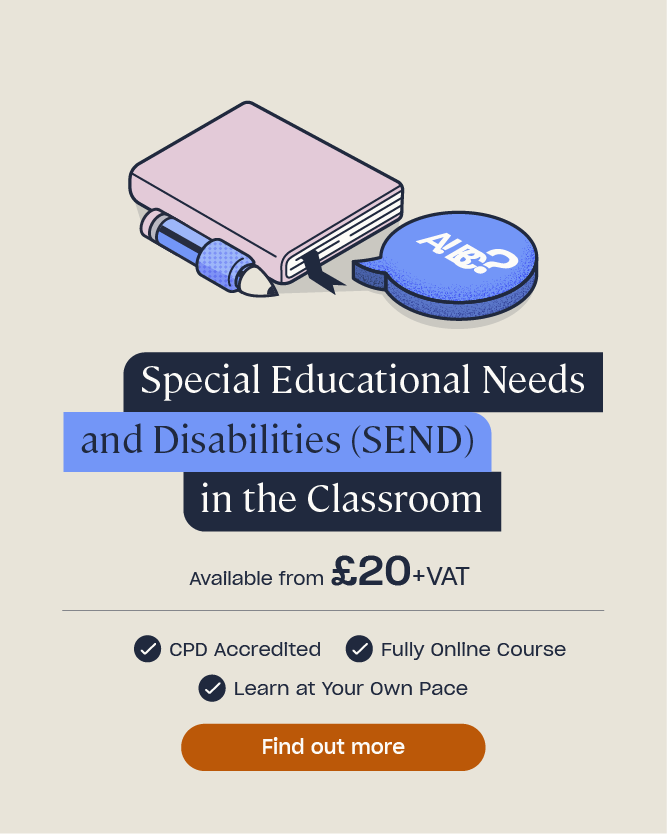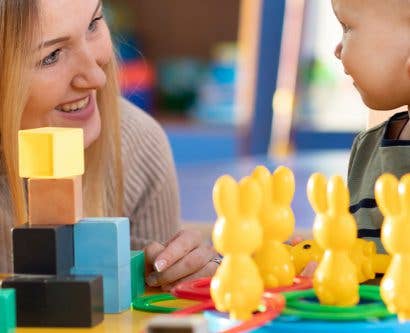What is SEND in Early Years?
As a teacher, early years practitioner, parent or another figure who supports young children, you have a responsibility to protect and help them. A key part of this may be having knowledge of special educational needs and disabilities (SEND). Having this knowledge means that if you have concerns, you can help children undertake an assessment to determine whether there are factors such as an underlying learning or communication difficulty.
It is important to provide the best possible education for each individual child, no matter what their needs may be. A key part of this is having the means to support all children and their families. SEND is common in the early years foundation stage (EYFS) and spotting signs and symptoms early is key to helping the child.
In this article, we will explain what SEND in early years is, how it fits into the EYFS framework, and how to support children with SEND in early years.
What is SEND in Early Years?

SEND is defined in the SEND Code of Practice (2015) as “A child or young person has SEND if they have a learning difficulty which calls for special educational provision to be made for him or her. A child of compulsory school age or a young person has a learning difficulty or disability if he or she:
- Has a significantly greater difficulty in learning than the majority of others of the same age.
- Has a disability which prevents or hinders him or her from making use of facilities of a kind generally provided for others of the same age in mainstream schools or mainstream-post 16 institutions.”
The Equality Act 2010 defines disability as “A person has a disability for the purposes of the Equality Act if they have a physical or mental impairment and the impairment has a substantial and long-term adverse effect on his or her ability to carry out normal day-to-day activities.” a disability can arise from a wide range of impairments. It is not always necessary to identify a child as having a specific or diagnosable condition. This can be difficult, because the underlying cause of their symptoms may be hard to establish. Instead, we must consider the effect the impairment is having on them. Under the Equality Act 2010, settings are also required to make reasonable adjustments to support a child.
Recognising SEND in early childhood is pivotal, as these are the years in which children are more impressionable and start to develop. This is why SEND is such an important topic to be knowledgeable on as an early years practitioner. As someone who works with children, you should be alert and aware of difficulties that some children may face in relation to SEND. In doing so, you can respond to early concerns to assist in the support of children with SEND.
For children aged two or more, special educational provision is giving access to education that is additional to, or different from that of other children of the same age. Alternatively, if a child is under the age of two, the special educational provision refers to the educational provision of any kind. Having such measures in place is important for children who have greater difficulty in learning than their peers, or have a disability that makes it harder for the child to make use of certain facilities and learning approaches.
All children have the right to an education which gives them the tools to achieve their goals and become confident young children. Early years education is especially important in providing young children with the means to transition into compulsory education as they get older. In light of this growing need, it is vital that education professionals in all education settings understand how to support children with SEND to achieve their best possible outcomes.
Looking to learn more?
It is important for those working with children of any age, to be aware of SEND. To learn more, take a look at our Special Educational Needs and Disabilities (SEND) in the Classroom Training.
Delay in learning and development, or behavioural issues in the early years may not necessarily indicate that a child has SEND and you, as an early years practitioner, should not diagnose them. However, having the knowledge can help you support the child and offer guidance to their parents or carers.
However, it is still useful for you to be aware and have knowledge of signs to look out for, so you can pass on any concerns or observations you may have to those who can help. You should follow the graduated approach, as outlined in the SEND Code of Practice (2015). We will look at this in more detail, later on in the article.

In England, during the academic year of 2021/22 there were just over 170,000 children aged 5 and under receiving support for SEN, either through EHC or SEN Support. It is recognised that children with SEND are impacted in their ability to learn. Some children may lack the skills to access and engage in the curriculum. Having SEND can affect their:
- Reading and writing skills.
- Mathematical ability.
- Ability to process information and understand things.
- Social skills.
- Cognitive skills, such as concentration or organisation.
A Special Educational Needs Coordinator (SENCo) is especially important in situations where you may not be in a position to act further, as they can coordinate provision for children with SEND and provide professional guidance and support to colleagues on SEND.
There are many types of special educational needs and the SEND Code of Practice (2015) defines four broad areas of need, as follows:
- Communication and interaction.
- Cognition and learning.
- Social, emotional and mental health.
- Sensory and/or physical needs.
While some children have difficulties that fit clearly into one of these areas, others have needs that come across two or more areas, also be aware that their needs may change over time.
It is because of these areas in need of support, that SEND is so important during a child’s early years and education. Combining the governing principles of the EYFS with the requirements of the SEND Code of Practice (2015) is an essential part of ensuring all children are met with equity in their opportunities for education.
How Does SEND Fit Into the EYFS Framework?
All children deserve a supportive and fulfilling environment to help guide them to the best possible start to their life and education. The EYFS sets the standards that all early years practitioners must follow to ensure that children under their care can learn and develop in a safe and healthy environment. The EYFS requires all early years providers to have arrangements in place to support children with SEND and provide parents with information on this.
To learn more about the EYFS framework, take a look at our article, here.
SEND and EYFS are intrinsically linked. In order to provide children with care, education and support, you must follow what is set out in the EYFS guidelines. They also state that those who work with young children must be knowledgeable about, and aware of potential difficulties a child may be facing. This means early years practitioners are able to respond early to concerns and work with parents and doctors or GPs.
The EYFS framework requires non-maintained providers to have arrangements in place for meeting children’s special educational needs. These settings within early years must promote equal opportunities for children. All providers funded by the local authority, to deliver early education places must have regard to the SEND Code of Practice (2015). The EYFS also states that maintained nursery schools must identify a staff member to act as SENCo to assist this and expects that other providers do the same.
The role of a SENCo within an Early Years setting includes:
- Ensure all practitioners in the setting understand their responsibilities to children with SEN and the setting’s approach to identifying and meeting SEN.
- Provide advice and support to colleagues.
- Ensure parents and carers are closely involved throughout and that their insights inform action taken by the setting.
- Liaising with external professionals or agencies.
Local authorities are responsible for statutory functions in relation to children (0-5) with SEND. Part of this responsibility is providing guidance and information to support children with SEND, and signposting practitioners, parents and carers to what is available through the ‘Local Offer’. The Local Offer is an information directory where you can go to find out what support or provision is available in your local area. It will include information on specialist teachers, therapy services such as speech and language therapy, Health Visitors and the Area SENCo. Click here to find out more about the Local Offer.
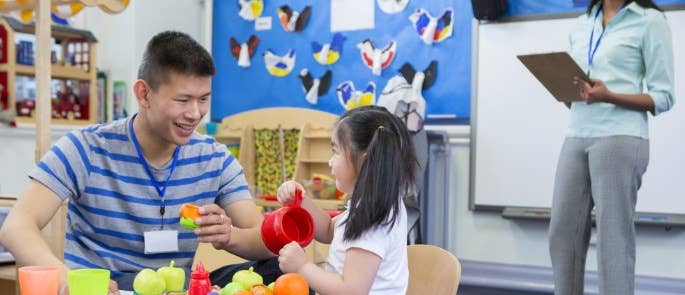
Consistency in the quality of early years settings is essential to ensure no child is left behind, struggling as their peers progress. Equal opportunities and anti-discriminatory practices put in place by The Equality Act 2010 and reiterated by the EYFS Framework, must make sure that every child is included and supported to help them achieve their best. The benefits of inclusive practices within early years are tenfold but of course, show the most reward to the children that it supports.
For more information and training within the education sector, take a look at the wide array of courses we offer at High Speed Training, here.
Once you understand how SEND fits into the EYFS, it’s important to learn how you can support children with SEND in their early years.
How to Support Children with SEND in Early Years
Supporting children with SEND in early years is essential. Early identification, followed by providing effective provision, improves a child’s long-term outcomes. Effective provision includes high-quality teaching and making reasonable adjustments in order to remove barriers a child faces. Having a SEND can impact a child’s mental health and early identification can reduce consequences such as low self-esteem, frustration and behavioural challenges. Early diagnosis and action moving on from this increases awareness and understanding of a child’s difficulties and adds an extra legislative aid.
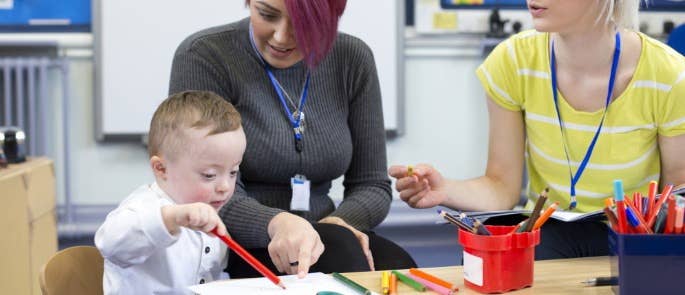
Some ways of supporting children with SEND will simply be an extension of your general good practice as an early years practitioner. However, other, more specific strategies will be required.
Some key ways you can support those in early years who may have special educational needs are:
- Create a positive and supportive environment for all pupils, without exception.
- Build a holistic overview of the children under your care, their needs, personalities and potential signs of SEND.
- Communicate with both parents and child as well as your SENCo.
- Consider your space, ensuring it is organised in a way to support children with SEND.
- Have high expectations of children.
The graduated approach is a key part of supporting children with SEND, and should be led and coordinated by the SENCo. It involves four steps:
- Assess – use a range of assessment strategies to analyse and identify the specific support needs of the child.
- Plan – starting from the assessment, co-produce and share a plan detailing the provision to be put in place. There should be a clear date to review.
- Do – implement the agreed provision.
- Review – monitor the child’s progress and evaluate the success and impact of the support given.
In Early Years, most assessments will be carried out by observing the child. Use this time to really get to know the child and understand their needs. Observations should be clear, factual and precise. Describe interactions the child has with other children. Keep an accurate record of anything a child says, for example, if a child says ‘I taw a tat’, write it as they say it, rather than ‘I saw a cat’.

Your analysis of the assessments should provide you with an indication of where the child’s strengths and difficulties lie, their interests, the progress that they are making, and identify any barriers to learning they might be experiencing. In the case of children who have, or are suspected to have, SEND, the focus then needs to be pulled even tighter, and the assessments should dig deeper.
During assessments, you should aim to gather as much relevant information as possible to build a complete view of the child. Supporting children with SEND exists outside of the learning environment. It is a collaborative process by yourself, the SENCo and the child’s carers or family. You can assist by providing as much information as possible.
To learn more about the graduated approach, take a look at our article, here.
SEND support extends past early years, to schooling, and into post-16 institutions, so it may be useful for you to understand how support might look later on. To learn about supporting children with SEND in the classroom, take a look at our article.
Strategies for Helping Children with SEND in Early Years
Having strategies in place is an essential part of supporting children with SEND. Examples of some tips, activities, strategies and resources you can use are:
- Keep your knowledge up to date – be aware of different types of SEND, and how to support children based on the best advice and evidence.
- Develop high-quality universal provision – this is essential for children with SEND, but also hugely benefits all children. This covers the learning environment, high-quality teaching and interactions, questioning, planning, differentiation, and personalised learning. Developing high-quality universal provision reduces the need for future targeted provision (such as interventions).
- Focus on inclusive practice – a learning environment which makes changes and modifications will reduce barriers to learning. Children will need different levels and types of support in order to achieve their potential. Ensure that children with SEND are included with other children who do not have SEND.
- Interactions with the child – allowing the child to take the lead ensures they feel their efforts are valued and important. Show them that you will always respond – even if they’re not saying any words you can understand. Use descriptive commentary, to provide a gentle running commentary on what the child is doing and what is happening in the situation.
- Responding to concerns – if you have concerns, look at the child’s development in more detail and compare with typical development ages and stages.
- Develop effective and supportive partnerships with parents – communicate regularly, involve them with decisions about support and signpost parents to further support.
- Speech, Language and Communication Needs (SLCN) are the most prevalent, and increasing type of need in Early Years. Here is an article outlining some key strategies for supporting SLCN within Early Years, along with some resources.

Below you’ll find two scenarios briefly outlining how the graduated approach was used to provide support. Consider how the graduated approach was applied here, and how you can use it within your setting.
Four-year-old Noah finds it difficult to sit comfortably on a chair. Observations show that he also struggles with climbing and catching a large ball. You plan activities which encourage development of core strength, such as soft play and riding a tricycle, whilst also looking at the classroom furniture to see if the table and chairs are the right height for him. You continue to follow the graduated approach to review the outcome.
Two-year-old Mae isn’t responding to her name or following simple instructions. She also prefers playing alone. You speak to her parents and agree she needs to see her health visitor about organising a hearing test. Tests show she has ‘glue ear’, which is monitored to see if it clears up. Meanwhile, the listening environment of the setting is assessed and improved, and communication cards are used to help Mae to express herself and understand instructions. You continue to follow the graduated approach to review the outcome.
Every child deserves the best possible education and this stands true in early years. As an early years practitioner, awareness is essential. You need to monitor and observe the children in your care so that they can get the best possible support and thus, education as soon as possible.
Further Resources:
- Special Educational Needs and Disabilities (SEND) in the Classroom
- How to Become a SEN Teacher
- Supporting Pupils with SEN in the Classroom: Guidance for Teachers
- Summary of the SEND and Alternative Provision (AP) Improvement Plan
- How to Support Children with Disabilities to be Active
- 7 Creative Classroom Exercises for Teaching SEN Children
- Special Educational Needs & Disability (SEND) Quiz


